Matrix
- 48. Rotate Image
- 54. Spiral Matrix
- 59. Spiral Matrix II
- 73. Set Matrix Zeroes
- 240. Search a 2D Matrix II
48. Rotate Image
You are given an n x n 2D matrix representing an image, rotate the image by 90 degrees (clockwise).
You have to rotate the image in-place, which means you have to modify the input 2D matrix directly. DO NOT allocate another 2D matrix and do the rotation.
Example 1:
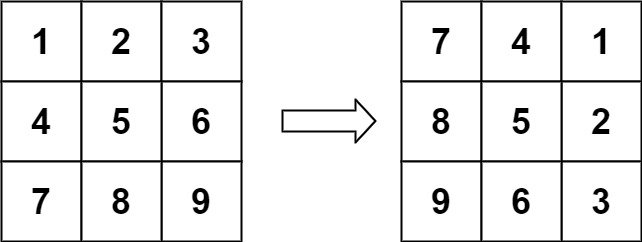
Input: matrix = [[1,2,3],[4,5,6],[7,8,9]]
Output: [[7,4,1],[8,5,2],[9,6,3]]
Example 2:
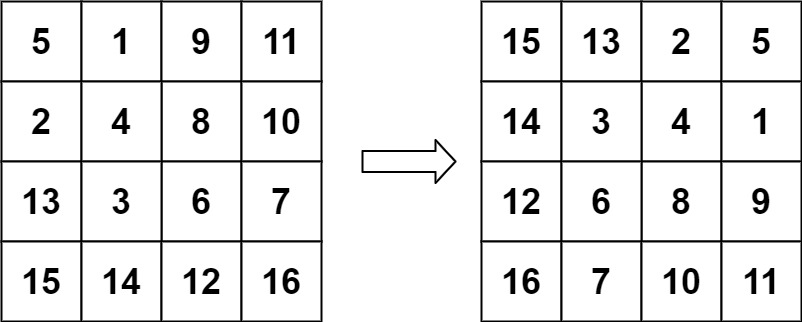
Input: matrix = [[5,1,9,11],[2,4,8,10],[13,3,6,7],[15,14,12,16]]
Output: [[15,13,2,5],[14,3,4,1],[12,6,8,9],[16,7,10,11]]
Constraints:
n == matrix.length == matrix[i].length1 <= n <= 20-1000 <= matrix[i][j] <= 1000
思路
Input: matrix = [[1,2,3],[4,5,6],[7,8,9]]
先以上下分界线对称交换两行,此时矩阵如下所示:
matrix = [[7,8,9],[4,5,6],[1,2,3]]
主对角线位置上的元素被放置到合适的位置
最后交换主对角线两侧的元素得到最终结果。
Output: [[7,4,1],[8,5,2],[9,6,3]]
核心操作
Vertical Flip:
- The first part of the algorithm vertically flips the matrix. It swaps the elements in the top row with the corresponding elements in the bottom row, moving towards the center row.
- Example before vertical flip (3x3 matrix):
1 2 3
4 5 6
7 8 9
- Example after vertical flip:
7 8 9
4 5 6
1 2 3
Transpose:
- The second part of the algorithm transposes the matrix. It swaps the elements at positions
[i][j]with the elements at[j][i], effectively turning rows into columns and vice versa. - Example after transpose:
7 4 1
8 5 2
9 6 3
Combining these two operations results in rotating the matrix by 90 degrees clockwise.
Summary
This algorithm efficiently rotates a matrix by 90 degrees clockwise by first flipping it vertically and then transposing it. This approach leverages the properties of matrix operations to achieve the desired transformation with minimal code complexity.
C++ 解法
Java 解法
class Solution {
public void rotate(int[][] matrix) {
int top = 0, bottom = matrix.length - 1;
while(top < bottom){
for(int i = 0; i < matrix[0].length; i++){
int temp = matrix[top][i];
matrix[top][i] = matrix[bottom][i];
matrix[bottom][i] = temp;
}
top++;
bottom--;
}
for(int row = 0; row < matrix.length; row++){
for(int col = row + 1; col < matrix[0].length; col++){
int temp = matrix[row][col];
matrix[row][col] = matrix[col][row];
matrix[col][row] = temp;
}
}
}
}
Python 解法
54. Spiral Matrix
Given an m x n matrix, return all elements of the matrix in spiral order.
Example 1:
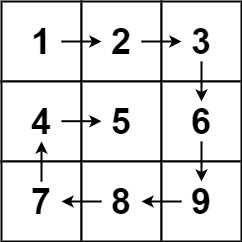
Input: matrix = [[1,2,3],[4,5,6],[7,8,9]]
Output: [1,2,3,6,9,8,7,4,5]
Example 2:

Input: matrix = [[1,2,3,4],[5,6,7,8],[9,10,11,12]]
Output: [1,2,3,4,8,12,11,10,9,5,6,7]
Constraints:
m == matrix.lengthn == matrix[i].length1 <= m, n <= 10-100 <= matrix[i][j] <= 100
思路
注意:这里不一定是一个方阵
方法一:模拟
可以模拟螺旋矩阵的路径。初始位置是矩阵的左上角,初始方向是向右,当路径超出界限或者进入之前访问过的位置时,顺时针旋转,进入下一个方向。
判断路径是否进入之前访问过的位置需要使用一个与输入矩阵大小相同的辅助矩阵 visited,其中的每个元素表示该位置是否被访问过。当一个元素被访问时,将 visited 中的对应位置的元素设为已访问。
如何判断路径是否结束?由于矩阵中的每个元素都被访问一次,因此路径的长度即为矩阵中的元素数量,当路径的长度达到矩阵中的元素数量时即为完整路径,将该路径返回。
复杂度分析
时间复杂度:O(mn),其中 m 和 n 分别是输入矩阵的行数和列数。矩阵中的每个元素都要被访问一次。
空间复杂度:O(mn)。需要创建一个大小为 m×n 的矩阵 visited 记录每个位置是否被访问过。
方法二:按层模拟
可以将矩阵看成若干层,首先输出最外层的元素,其次输出次外层的元素,直到输出最内层的元素。
定义矩阵的第 k 层是到最近边界距离为 k 的所有顶点。例如,下图矩阵最外层元素都是第 1 层,次外层元素都是第 2 层,剩下的元素都是第 3 层。
[[1, 1, 1, 1, 1, 1, 1],
[1, 2, 2, 2, 2, 2, 1],
[1, 2, 3, 3, 3, 2, 1],
[1, 2, 2, 2, 2, 2, 1],
[1, 1, 1, 1, 1, 1, 1]]
对于每层,从左上方开始以顺时针的顺序遍历所有元素。假设当前层的左上角位于 (top,left),右下角位于 (bottom,right),按照如下顺序遍历当前层的元素。
从左到右遍历上侧元素,依次为 (top,left) 到 (top,right)。
从上到下遍历右侧元素,依次为 (top+1,right) 到 (bottom,right)。
如果 left<right 且 top<bottom,则从右到左遍历下侧元素,依次为 (bottom,right−1) 到 (bottom,left+1),以及从下到上遍历左侧元素,依次为 (bottom,left) 到 (top+1,left)。
遍历完当前层的元素之后,将 left 和 top 分别增加 1,将 right 和 bottom 分别减少 1,进入下一层继续遍历,直到遍历完所有元素为止。
复杂度分析
时间复杂度:O(mn),其中 m 和 n 分别是输入矩阵的行数和列数。矩阵中的每个元素都要被访问一次。
空间复杂度:O(1)。除了输出数组以外,空间复杂度是常数。
作者:力扣官方题解 链接: https://leetcode.cn/problems/spiral-matrix/solutions/275393/luo-xuan-ju-zhen-by-leetcode-solution/ 来源:力扣(LeetCode) 著作权归作者所有。商业转载请联系作者获得授权,非商业转载请注明出处。
C++ 解法
方法二:按层模拟
class Solution {
public:
vector<int> spiralOrder(vector<vector<int>>& matrix) {
if (matrix.size() == 0 || matrix[0].size() == 0) {
return {};
}
int rows = matrix.size(), columns = matrix[0].size();
vector<int> order;
int left = 0, right = columns - 1, top = 0, bottom = rows - 1;
while (left <= right && top <= bottom) {
for (int column = left; column <= right; column++) {
order.push_back(matrix[top][column]);
}
for (int row = top + 1; row <= bottom; row++) {
order.push_back(matrix[row][right]);
}
if (left < right && top < bottom) {
for (int column = right - 1; column > left; column--) {
order.push_back(matrix[bottom][column]);
}
for (int row = bottom; row > top; row--) {
order.push_back(matrix[row][left]);
}
}
left++;
right--;
top++;
bottom--;
}
return order;
}
};
Java 解法
方法二:按层模拟
class Solution {
public List<Integer> spiralOrder(int[][] matrix) {
List<Integer> order = new ArrayList<Integer>();
if (matrix == null || matrix.length == 0 || matrix[0].length == 0) {
return order;
}
int rows = matrix.length, columns = matrix[0].length;
int left = 0, right = columns - 1, top = 0, bottom = rows - 1;
while (left <= right && top <= bottom) {
for (int column = left; column <= right; column++) {
order.add(matrix[top][column]);
}
for (int row = top + 1; row <= bottom; row++) {
order.add(matrix[row][right]);
}
if (left < right && top < bottom) {
for (int column = right - 1; column > left; column--) {
order.add(matrix[bottom][column]);
}
for (int row = bottom; row > top; row--) {
order.add(matrix[row][left]);
}
}
left++;
right--;
top++;
bottom--;
}
return order;
}
}
Python3 解法
方法一:模拟
class Solution:
def spiralOrder(self, matrix: List[List[int]]) -> List[int]:
if not matrix or not matrix[0]:
return list()
rows, columns = len(matrix), len(matrix[0])
visited = [[False] * columns for _ in range(rows)]
total = rows * columns
order = [0] * total
directions = [[0, 1], [1, 0], [0, -1], [-1, 0]]
row, column = 0, 0
directionIndex = 0
for i in range(total):
order[i] = matrix[row][column]
visited[row][column] = True
nextRow, nextColumn = row + directions[directionIndex][0], column + directions[directionIndex][1]
if not (0 <= nextRow < rows and 0 <= nextColumn < columns and not visited[nextRow][nextColumn]):
directionIndex = (directionIndex + 1) % 4
row += directions[directionIndex][0]
column += directions[directionIndex][1]
return order
59. Spiral Matrix II
Given a positive integer n, generate an n x n matrix filled with elements from 1 to n2 in spiral order.
Example 1:
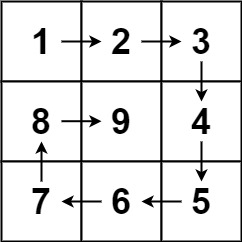
Input: n = 3
Output: [[1,2,3],[8,9,4],[7,6,5]]
Example 2:
Input: n = 1
Output: [[1]]
Constraints:
1 <= n <= 20
思路
坚持循环不变量原则
奇偶分开处理
圈数=n/2
C++
class Solution {
public:
vector<vector<int>> generateMatrix(int n) {
vector<vector<int>> result(n, vector<int>(n,0));
int startx = 0;
int starty = 0;
int offset = 1;
int count = 1;
int i;
int j;
int loop = n / 2;
while(loop--)
{
i = startx;
j = starty;
for(j = starty; j < n - offset; j++)
{
result[i][j] = count++;
}
for(i = startx; i < n - offset; i++)
{
result[i][j] = count++;
}
for(; j > starty; j--)
{
result[i][j] = count++;
}
for(; i > startx; i--)
{
result[i][j] = count++;
}
startx++;
starty++;
offset++;
}
if(n % 2 == 1)
result[n / 2][n / 2] = count;
return result;
}
};
Java
class Solution {
public int[][] generateMatrix(int n) {
int[][] result = new int[n][n];
int counter = 1;
int startx = 0;
int starty = 0;
int offset = 1;
int numOfLoop = n / 2;
while((numOfLoop--) > 0){
for(int j = starty; j < n - offset; j++){
result[startx][j] = counter++;
}
for(int i = starty; i < n - offset; i++){
result[i][n - offset] = counter++;
}
for(int j = n - offset; j > startx; j--){
result[n - offset][j] = counter++;
}
for(int i = n - offset; i > starty; i--){
result[i][starty] = counter++;
}
startx++;
starty++;
offset++;
}
if(n % 2 == 1){
result[n/2][n/2] = counter;
}
return result;
}
}
Python
class Solution(object):
def generateMatrix(self, n):
top, bottom, left, right = 0, n-1, 0, n - 1
val = 1
arr = [[0] * n for _ in range(n)]
while left <= right and top <= bottom:
for j in range(left, right + 1):
arr[top][j] = val
val += 1
top += 1
for i in range(top, bottom + 1):
arr[i][right] = val
val += 1
right -= 1
for j in range(right, left - 1, -1):
arr[bottom][j] = val
val += 1
bottom -= 1
for i in range(bottom, top - 1, -1):
arr[i][left] = val
val += 1
left += 1
return arr
73. Set Matrix Zeroes
Given an m x n integer matrix matrix, if an element is 0, set its entire row and column to 0's.
You must do it in place.
Example 1:

Input: matrix = [[1,1,1],[1,0,1],[1,1,1]]
Output: [[1,0,1],[0,0,0],[1,0,1]]
Example 2:

Input: matrix = [[0,1,2,0],[3,4,5,2],[1,3,1,5]]
Output: [[0,0,0,0],[0,4,5,0],[0,3,1,0]]
Constraints:
m == matrix.lengthn == matrix[0].length1 <= m, n <= 200-2^31 <= matrix[i][j] <= 2^31 - 1
Follow up:
- A straightforward solution using
O(mn)space is probably a bad idea. - A simple improvement uses
O(m + n)space, but still not the best solution. - Could you devise a constant space solution?
思路
方法一:使用两个标记数组
思路和算法
我们可以用两个标记数组分别记录每一行和每一列是否有零出现。
具体地,我们首先遍历该数组一次,如果某个元素为 0,那么就将该元素所在的行和列所对应标记数组的位置置为 true。最后我们再次遍历该数组,用标记数组更新原数组即可。
复杂度分析
时间复杂度:O(mn),其中 m 是矩阵的行数,n 是矩阵的列数。我们至多只需要遍历该矩阵两次。
空间复杂度:O(m+n),其中 m 是矩阵的行数,n 是矩阵的列数。我们需要分别记录每一行或每一列是否有零出现。
方法二:使用两个标记变量
思路和算法
我们可以用矩阵的第一行和第一列代替方法一中的两个标记数组,以达到 O(1) 的额外空间。但这样会导致原数组的第一行和第一列被修改,无法记录它们是否原本包含 0。因此我们需要额外使用两个标记变量分别记录第一行和第一列是否原本包含 0。
在实际代码中,我们首先预处理出两个标记变量,接着使用其他行与列去处理第一行与第一列,然后反过来使用第一行与第一列去更新其他行与列,最后使用两个标记变量更新第一行与第一列即可。
复杂度分析
时间复杂度:O(mn),其中 m 是矩阵的行数,n 是矩阵的列数。我们至多只需要遍历该矩阵两次。
空间复杂度:O(1)。我们只需要常数空间存储若干变量。
方法三:使用一个标记变量
思路和算法
我们可以对方法二进一步优化,只使用一个标记变量记录第一列是否原本存在 0。这样,第一列的第一个元素即可以标记第一行是否出现 0。但为了防止每一列的第一个元素被提前更新,我们需要从最后一行开始,倒序地处理矩阵元素。
复杂度分析
时间复杂度:O(mn),其中 m 是矩阵的行数,n 是矩阵的列数。我们至多只需要遍历该矩阵两次。
空间复杂度:O(1)。我们只需要常数空间存储若干变量。
作者:力扣官方题解 链接:https://leetcode.cn/problems/set-matrix-zeroes/solutions/669901/ju-zhen-zhi-ling-by-leetcode-solution-9ll7/ 来源:力扣(LeetCode) 著作权归作者所有。商业转载请联系作者获得授权,非商业转载请注明出处。
C++ 解法
方法二:使用两个标记变量
class Solution {
public:
void setZeroes(vector<vector<int>>& matrix) {
int m = matrix.size();
int n = matrix[0].size();
int flag_col0 = false, flag_row0 = false;
for (int i = 0; i < m; i++) {
if (!matrix[i][0]) {
flag_col0 = true;
}
}
for (int j = 0; j < n; j++) {
if (!matrix[0][j]) {
flag_row0 = true;
}
}
for(int i = 1; i < m; i++){
for(int j = 1; j < n; j++){
if(matrix[i][j] == 0){
matrix[i][0] = 0;
matrix[0][j] = 0;
}
}
}
for (int i = 1; i < m; i++) {
for (int j = 1; j < n; j++) {
if (!matrix[i][0] || !matrix[0][j]) {
matrix[i][j] = 0;
}
}
}
if (flag_col0) {
for (int i = 0; i < m; i++) {
matrix[i][0] = 0;
}
}
if (flag_row0) {
for (int j = 0; j < n; j++) {
matrix[0][j] = 0;
}
}
}
};
Java 解法
方法一:使用两个标记数组
class Solution {
public void setZeroes(int[][] matrix) {
int m = matrix.length;
int n = matrix[0].length;
boolean[] row = new boolean[m];
boolean[] col = new boolean[n];
for(int i = 0; i < m; i++){
for(int j = 0; j < n; j++){
if(matrix[i][j] == 0){
row[i] = true;
col[j] = true;
}
}
}
for(int i = 0; i < m; i++){
for(int j = 0; j < n; j++){
if(row[i] || col[j]){
matrix[i][j] = 0;
}
}
}
}
}
Python3 解法
方法三:使用一个标记变量
class Solution:
def setZeroes(self, matrix: List[List[int]]) -> None:
m, n = len(matrix), len(matrix[0])
flag_col0 = False
for i in range(m):
if matrix[i][0] == 0:
flag_col0 = True
for j in range(1, n):
if matrix[i][j] == 0:
matrix[i][0] = matrix[0][j] = 0
for i in range(m - 1, -1, -1):
for j in range(1, n):
if matrix[i][0] == 0 or matrix[0][j] == 0:
matrix[i][j] = 0
if flag_col0:
matrix[i][0] = 0
240. Search a 2D Matrix II
Write an efficient algorithm that searches for a value target in an m x n integer matrix matrix. This matrix has the following properties:
- Integers in each row are sorted in ascending from left to right.
- Integers in each column are sorted in ascending from top to bottom.
Example 1:
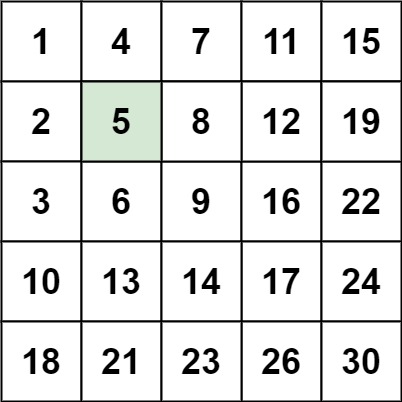
Input: matrix = [[1,4,7,11,15],[2,5,8,12,19],[3,6,9,16,22],[10,13,14,17,24],[18,21,23,26,30]], target = 5
Output: true
Example 2:
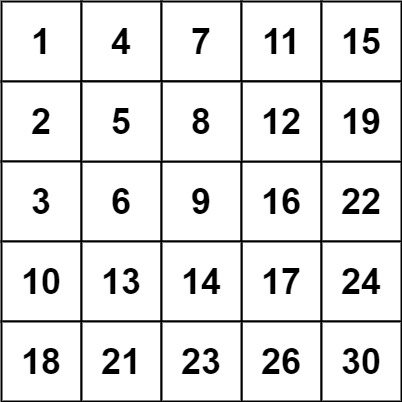
Input: matrix = [[1,4,7,11,15],[2,5,8,12,19],[3,6,9,16,22],[10,13,14,17,24],[18,21,23,26,30]], target = 20
Output: false
Constraints:
m == matrix.lengthn == matrix[i].length1 <= n, m <= 300-10^9 <= matrix[i][j] <= 10^9- All the integers in each row are sorted in ascending order.
- All the integers in each column are sorted in ascending order.
-10^9 <= target <= 10^9
思路
方法一:直接查找
思路与算法
我们直接遍历整个矩阵 matrix,判断 target 是否出现即可。
复杂度分析
时间复杂度:O(mn)。
空间复杂度:O(1)。
方法二:二分查找
思路与算法
由于矩阵 matrix 中每一行的元素都是升序排列的,因此我们可以对每一行都使用一次二分查找,判断 target 是否在该行中,从而判断 target 是否出现。
复杂度分析
时间复杂度:O(mlogn)。对一行使用二分查找的时间复杂度为 O(logn),最多需要进行 m 次二分查找。
空间复杂度:O(1)。
方法三:Z 字形查找
思路与算法
我们可以从矩阵 matrix 的右上角 (0,n−1) 进行搜索。在每一步的搜索过程中,如果我们位于位置 (x,y),那么我们希望在以 matrix 的左下角为左下角、以 (x,y) 为右上角的矩阵中进行搜索,即行的范围为 [x,m−1],列的范围为 [0,y]:
如果 matrix[x,y]=target,说明搜索完成;
如果 matrix[x,y]>target,由于每一列的元素都是升序排列的,那么在当前的搜索矩阵中,所有位于第 y 列的元素都是严格大于 target 的,因此我们可以将它们全部忽略,即将 y 减少 1;
如果 matrix[x,y]<target,由于每一行的元素都是升序排列的,那么在当前的搜索矩阵中,所有位于第 x 行的元素都是严格小于 target 的,因此我们可以将它们全部忽略,即将 x 增加 1。
在搜索的过程中,如果我们超出了矩阵的边界,那么说明矩阵中不存在 target。
复杂度分析
时间复杂度:O(m+n)。在搜索的过程中,如果我们没有找到 target,那么我们要么将 y 减少 1,要么将 x 增加 1。由于 (x,y) 的初始值分别为 (0,n−1),因此 y 最多能被减少 n 次,x 最多能被增加 m 次,总搜索次数为 m+n。在这之后,x 和 y 就会超出矩阵的边界。
空间复杂度:O(1)。
作者:力扣官方题解 链接: https://leetcode.cn/problems/search-a-2d-matrix-ii/solutions/1062538/sou-suo-er-wei-ju-zhen-ii-by-leetcode-so-9hcx/ 来源:力扣(LeetCode) 著作权归作者所有。商业转载请联系作者获得授权,非商业转载请注明出处。
C++ 解法
方法二:二分查找
class Solution {
public:
bool searchMatrix(vector<vector<int>>& matrix, int target) {
for (const auto& row: matrix) {
auto it = lower_bound(row.begin(), row.end(), target);
if (it != row.end() && *it == target) {
return true;
}
}
return false;
}
};
Java 解法
方法三:Z 字形查找
class Solution {
public boolean searchMatrix(int[][] matrix, int target) {
int m = matrix.length, n = matrix[0].length;
int x = 0, y = n - 1;
while (x < m && y >= 0) {
if (matrix[x][y] == target) {
return true;
}
if (matrix[x][y] > target) {
--y;
} else {
++x;
}
}
return false;
}
}
Python 解法
方法一:直接查找
class Solution:
def searchMatrix(self, matrix: List[List[int]], target: int) -> bool:
for row in matrix:
for element in row:
if element == target:
return True
return False